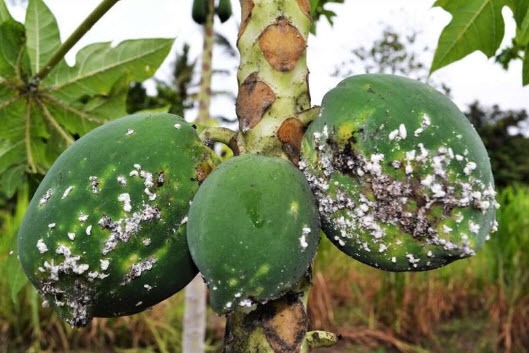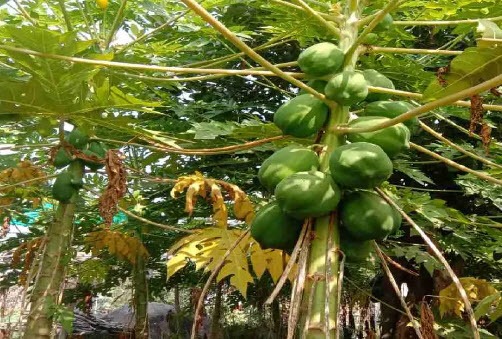Story of Day :
Pests and diseases can be determining factors in papaya cultivation.
Its attack damage will result in a decrease in the quality and quantity of production.
Even more seriously, the spoiled fruit is worthless; the whole plant can die.
Therefore, the prevention of pests and diseases is essential.
Contents
Papaya Pests

Mite
Seven mites attack papaya plants sucking fluid from leaf, stem, and fruit tissue cells with needle-shaped mouths.
As a result, the leaves become wrinkled, fall faster, and the power of plant growth decreases and stagnates.
The resulting fruit is wrinkled. Its life knows no seasons.
The seven types of mites are:
- Polyphagotarsonemus latus BANKS (Fam. Tarsomidae) attacks seedlings.
- Tetranychus telarius L (Fam Tetranychidae)
- Eutetranychus banka Mc GREGOR (Fam Tetranychidae)
- Panonychus Citri Mc. GREGOR (Fam. Tetranychidae) All three attack old leaves. The first type is more dangerous than the other two types; because it can live on other plants.
- Brevipalpus Phoenicis GEYSKES (Fam Tenuipalpidae) attacks the fruit with wrinkled spots.
- Tuckerella Pavoriformis EWING (Fam. Tuckerellidae)
- Tuckerella Ornata TUCKER (Fam. Tuckerellidae) both attack stems.
All these pests can be eradicated with Kelthane or Moresan at a dose of 0.125%.
Lice
Several types of ticks attack papaya plants, of which the important one is Myzuz Persicae.
These lice live under papaya leaves and suck the leaf tissue cell fluid. As a result, the leaves become wrinkled.
These lice, by the secretions they secrete, live in symbiosis with ants.
But more importantly, these fleas can be an intermediary for papaya mosaic virus disease.
These lice can be eradicated with Tamaron at a dose of 0.10-0.20%, Hosthation 40 EC at a dose of 0.10-0.15%, or Orthene 75 SP at a dose of 0.1%.
Also, read about how to grow and care papaya tree.
Papaya Diseases

Bacterial Necrosis Disease (Bacillus Papayae RANT)
This disease was discovered in Java and the Maluku Islands in 1931.
Young leaves that are attacked turn yellow and rot. Then the entire top of the plant is damaged.
Prevention is only by removing the leaves affected by the attack; the leaves are burned. No other way yet.
Powdery Mildew disease (Oidium Caricae NOA CK)
Attacks seedlings and old leaves when the humidity is high enough. On the underside of the leaves, there are white powdery spots.
While at the top, usually near the leaf bones, there are yellow or pale green spots.
Prevented by spraying a dose of 0.7% sulfur; only when the air temperature is hot enough above 33 C can this spraying be detrimental and injure papaya plants.
This disease is spread by wind.
Damping off wilt disease
This disease attacks seedlings: it can be caused by the fungi Pythium Aphanidermatum, Pythium Ultimum, Phytophthora palmivora, or Rhizoctonia sp that live in the soil.
Attacks plants when the air is humid (especially in dense gardens) and hot.
Attacks occur quickly; the root neck becomes watery and destroys and kills these tissues.
If so, the seedling plant cannot be helped anymore.
Mature plants are resistant to this disease. The eradication of fungicide does not yet exist.
Prevention efforts that can be done are using a good technical culture.
Efforts are made so that the nursery soil does not get wet; drainage must be good.
If necessary, the nursery medium is sterilized using formalin.
Phytophthora Blight disease
This disease is caused by the fungus Phytophthora palmivora, attacking mainly the upper part of the plant, on the stem and fruit.
In addition, this fungus can also cause root rot disease, Damping off wilt disease, and stem cancer.
The attacked stems, especially in the fruit area, are marked by white spots on the stems and fruit.
When the attack increases, all stem parts are affected by spots, which eventually wilt and die.
Whole fruit can be affected; the fruit becomes shriveled dark brown and then falls.
This disease is spread by wind and rain.
Prevention can be done by spraying the plants with 0.2% Dithane M45; in the dry season, it is sprayed in 10 days, while in the rainy season, it is seven days.
Plants and fruit that have been attacked must be dismantled and burned.
Anthracnose (Colletotrichum gloeosporioides) fruit rot disease
This disease is caused by the fungus Colletotrichum gloeosporioides; Symptoms of a new attack appear when the fruit is ripe, in the form of small dark circles.
These spheres get bigger and concave rotten inward as the fruit ripens.
On the unripe fruit, this fungus attacks in the form of small wounds marked by the thickened sap that comes out.
These wounds remain small as long as the fruit is unripe.
This disease can be prevented by spraying the fruit with Dithane M45 at a dose of 0.2%, an interval of 10 days in the dry season, and an interval of 7 days in the rainy season.
Fruit rot during storage can be prevented by dipping the fruit into hot water at 43-48 for 20 minutes.
Papaya Mosaic Disease
A virus causes this disease; Symptoms on plant shoots are stunted growth, and the leaves are curly (chlorotic) with transparent (yellowish) spots all over the strands or around the leaf bones.
Stems and petioles become finely mottled; the color becomes clear, and the spots become bigger as the attack increases.
While in fruit, at all age levels of fruit, dark green circles were found.
The disease cannot be eradicated; it is transmitted by a type of tick, Myzus Persicae. Prevention efforts are by:
- Eliminate all lice on diseased plants.
- Diseased plants must be dismantled and burned.
- Do not plant healthy plants near plants that are also sources of viral disease.
Diseases by Nematodes
It can be caused by Meloidogyne Incognita Acrita or by Rotylenchulus reniformis, which attack plant roots, causing puru-puru (lumps).
As a result, the growth and root system stop.
The leaves of the finished plant are yellow and fall quickly; small whole plant.
Prevention of attacks can use the nematicide Vapam.
In Hawaii, 225 kg of Vapam is used for 1 hectare of the crop, administered by pouring into each plant hole two weeks or more before planting.